Rajasthan Board RBSE Class 12 Economics Chapter 5 Concept of Supply
RBSE Class 12 Economics Chapter 5 Practice Questions
RBSE Class 12 Economics Chapter 5 Multiple Choice Questions
Question 1.
Which of the following factors affects the supply?
(a) Prices of the commodity
(b) Prices of means
(c) Change in technology
(d) All of these
Answer:
(d)
Question 2.
What type of relationship exists between price and its supply?
(a) Direct and positive
(b) Direct and negative
(c) Proportional
(d) Indirect
Answer:
(a)
Question 3.
Slope of normal supply curve is :
(a) positive
(b) rectangular
(c) negative
(d) None of these
Answer:
(a)
Question 4.
If a producer produces 200 units in a particular period of time, he makes available 180 units in the market for sale. Then supply in market is :
(a) 200
(b) 20
(c) 380
(d) 180
Answer:
(d)
Question 5.
Which factor is not responsible for change in supply curve?
(a) Price of raw material
(b) Change in technology
(c) Price of commodity
(d) Special occasions
Answer:
(c)
RBSE Class 12 Economics Chapter 5 Very Short Answer Type Questions
Question 1.
Define supply.
Answer:
The supply of a commodity implies that quantity of the commodity which a seller is eager to sell in a definite time period at a certain price.
Question 2.
What do you mean by stock?
Answer:
A stock refers to that total quantity of the commodity which is available in the market at a given point of time.
Question 3.
What is law of supply?
Answer:
‘When the price of a commodity rises, the quantity supplied of it in the market increases, and when the price of a commodity falls, its quantity supplied decreases, other factors determining supply remaining the same.’
Question 4.
Write the meaning of market supply.
Answer:
Market supply implies the sum total of quantity of commodity that is presented in the market for sale by all the producers.
RBSE Class 12 Economics Chapter 5 Short Answer Type Questions
Question 1.
Differentiate between supply and stock.
Answer:
Stock of a commodity means that the total quantity of commodity which is available in the market with the seller. Supply refers to that part of the stock that the seller is prepared to sell at a given price in a given period of time.
Question 2.
Write down any four assumptions of law of supply.
Answer:
Given below are four assumptions of law of supply:
- The prices of factors of production of a certain product do not show any changes.
- The technique of production does not show any change.
- There is no change in the prices of related goods.
- The taxes levied by government and the grants given should remain constant.
Question 3.
Write down any four reasons for application of law of supply.
Answer:
(i) Profit Maximization : The basic purpose of the producers is to maximize profit when supplying a commodity. Therefore, producers increase the supply of the product which are high priced, by increasing production.
(ii) Number of Companies Increases : The increase in the number of companies increase the supply of the market, however, as prices start falling, some companies who do not expect to earn any profits at low cost either stop production or reduce it. This reduces the supply of commodity because the number of companies in the market decreases.
(iii) Variation in Stock : When the price of a good increase, vendors are ready to supply more goods than their stock, however, at a relatively low cost, the producers do not release large amounts from their stock, they start increasing their stock with a view that price may increase in the near future.
(iv) Change in Technology: Change in technology also affects supply of the commodity. Improvement in the technique of production reduces cost of production. Consequently, profits tend to increase inducing an increase in supply.
Question 4.
Calculate market supply from the following data:
| Price | 10 | 20 | 30 | 40 | 50 | 60 | 70 |
| Supply of Firm A | 10 | 15 | 20 | 30 | 40 | 50 | 60 |
| Supply of Firm B | 20 | 30 | 40 | 60 | 80 | 100 | 120 |
Answer:
| Price | 10 | 20 | 30 | 40 | 50 | 60 | 70 |
| Supply of Firm A | 10 | 15 | 20 | 30 | 40 | 50 | 60 |
| Supply of Firm B | 20 | 30 | 40 | 60 | 80 | 100 | 120 |
| Market Supply | 10 + 20 = 30 | 15 + 30 = 45 | 20 + 40 = 60 | 30 + 60 = 90 | 40 + 80 = 120 | 50 + 100 = 150 | 60 + 120 = 180 |
Above schedule indicates that when price of commodity is ₹ 10, the firms will supply 30 units of a commodity. When price increases to ₹ 20, firm ‘A’ supplies 15 units and firm ‘B’ supplies 30 units. Thus, the market supply is 15 + 30 = 45 units. As the price rises, market supply also increases.
Question 5.
Explain shift in supply curve with the help of figure.
Answer:
When the change in supply is due to factors other than the price of the commodity, it is known as Increase or Decrease in Supply as the case may be. Since such changes in supply are shown by drawing a supply curve to the right or left of the original supply curve, so it is called Shifting of Supply Curve.
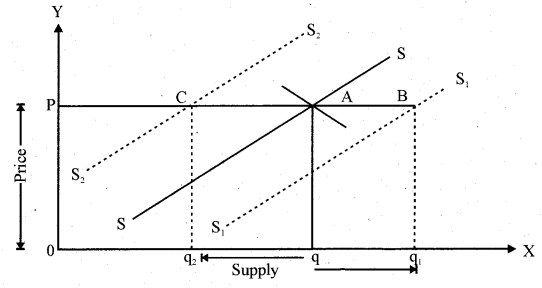
Shift in supply Curve
Increase in supply ……… From SS curve to S1 S1 (A to B)
Price …….. OP
Supply …….. Oq to Oq1
Decrease in supply …….. From SS curve to S2S2 (A to C)
Price …….. OP
Supply …….. Oq to Oq2
RBSE Class 12 Economics Chapter 5 Essay Type Questions
Question 1.
What is supply? Describe the factors affecting supply.
Answer:
Supply refers to the quantity of a commodity offered for sale considering different possible prices at a point of time. It is the price which significantly affects the supply of goods. In general, more goods are. offered for sale at the higher price, i.e. supply increases with the rise in price. In contrast, the supply decreases with the fall in price. Because price changes from time to time, so the supply of goods will also increase and decrease accordingly. According to McConnell, “Supply may be defined as a schedule which shows the various amounts of a product which a producer is willing to and able to produce and make available for sale in the market at each specific price in a set of possible prices, during some given period.”
Determinants of Supply or Factors Affecting Supply S = f (P, Pr, Pf, T, G, E, O)
(i) Price of the Product (P) : Other things being equal, when price increases then supply increases and when price decreases then supply decreases. Thus, there is positive relation between price and supply.
(ii) Price of Related Goods (Pr): The supply of a commodity depends upon the price of all other related commodities. If prices of related commodities (substitutes) rise, its supply will decrease, and the supply of this commodity will increase, since producers will increase production to earn more profits. Similarly, when the price of a complementary commodity increases, the demand of other product is reduced. Thus, producers reduce the production and supply of that commodity rises. But supply of another commodity will fall. So, there is an inverse relation.
(ii) Price of Factors of Production (Pf) (Cost of Production) : A rise in prices of factors of production of a commodity will make the production of that commodity less profitable, so supply will decrease. If cost of production decreases then supply will increase. There is also an inverse relation between supply and cost of production.
(iv) Technology (T): Technological advances based on new discoveries and innovations reduce the cost of production and results in more and more supply of the commodity, as the production and supply of the commodity becomes more profitable.
(v) Government Policy (G): The government policy may affect the supply by imposing taxes and providing subsidy. If government policies are favourable (decrease in taxes and increase in subsidy), then supply will increase, and if government policies are unfavourable (increase in taxes and decreases subsidy), then supply will fail.
(vi) Future Expectation About Price (E) : If there is future expectation about rise in price, then the supplier will not increase the supply at present, and if there is future expectation about fall in price, then the supplier will increase his supply.
(vii) Natural Factors (O) : Production of certain goods also depends on natural factors, i.e.. Agricultural produce. Thus, supply of agricultural producers influenced by natural factors. When natural factors are favourable, supply increases and vice-versa.
(viii) Goal of Producer : Whether the supply of a commodity will be less or more, depends on the goal of the producer. If the goal is not earning profit but establishing monopoly on market, he will try to maximise supply, even if he earns less profit.
(ix) Festival Time : Supply of various commodities increases generally at festive season, since producers know that demand of products rises at such time. In non-festival time, supply drops. For example, in wedding season, demand of commodities like TV, fridge, automobiles, clothes, jewellery etc. is much more, and so it is during the Diwali season.
(x) Transportation Cost: When transportation means are developed, the movement of goods is rapid and transportation cost is less. Thus, supply increases.
Question 2.
What do you mean by law of supply? Explain the law of supply with help of example, schedule and diagram.
Answer:
Law of supply states that, other things remaining constant, there is a positive relationship between price of a commodity and its quantity supplied. Thus, more quantity is supplied at higher price and less at the lower price.
Law of supply is explained with the help of the following supply schedule :
| Px (in₹) | Sx (Units) |
| 10 | 100 |
| 11 | 200 |
| 12 | 300 |
The table shows that quantity supplied increases from 100 to 200 units when price increases from ₹ 10 to ₹ 11 per unit. Supply Curve (SS) slopes upward and shows increase in quantity supplied in response to increase in price of ‘the commodity. Thus, quantity supplied increases from OL to OL1, when price rises from OP to OP1.
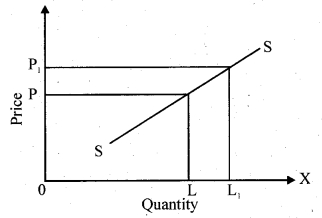
Question 3.
What are the factors responsible for shift in supply curve? How do technological changes affect the supply? Explain with help of a diagram.
Answer:
Factors responsible for shift in supply curve are based on two causes:
(i) Shift in supply curve occurs because of increase in supply, and increase in supply is influenced by these factors :
(a) Improvement in technology.
(b) Reduction in the price of factors of production causing fall in cost of production.
(c) When price of competing good decreases.
(d) Increase in number of firms in the market.
(e) When the firm expects a fall in the price of the commodity in the near future.
(f) When goal of the firm shifts from profit maximization to sales maximization.
(ii) Shift in supply curve because of decrease in supply, and decrease in supply is influenced by these factors :
(a) When the technique becomes obsolete, resulting in high cost of production.
(b) When factor prices increase, causing increase in cost of production.
(c) When prices of competing goods increase.
(d) Decrease in number of firms in the market.
(e) When the firm expects a rise in commodity price in the near future.
(f) Objective of the firm shifts from sales maximization to profit maximization.
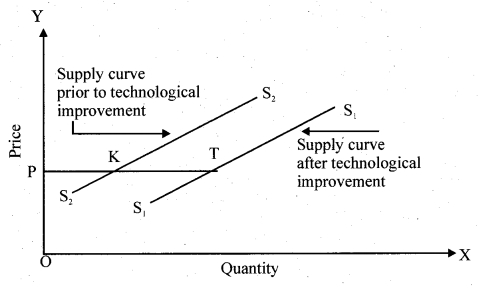
Technology improvement tends to lower the marginal and average cost of production. Because more can be produced with less and less additional resources. Accordingly, producers should be willing to supply more at the existing price. This implies a forward shift in supply curve which is seen by the figure.
The improvement in technology has the tendency of reducing the marginal and average cost of production. Because more and more production can be done with less and less additional resources, the producers should be ready to supply more at current prices. This means forward shift in the supply curve, as it is seen by the figure.
Initially, PK quantity was supplied at price OP. After technological improvement, PT quantity is supplied at the same price. It is a situation of rise in supply.
Question 4.
Explain extension and contraction of supply with the help of diagram.
Answer:
The term extension and contraction in supply is used for changes in quantity supplied as a result of changes in price of a commodity. When the rise in price of a commodity brings about increase in quantity supplied of the commodity, while other factors determining supply remaining constant, this is called Extension in Supply.
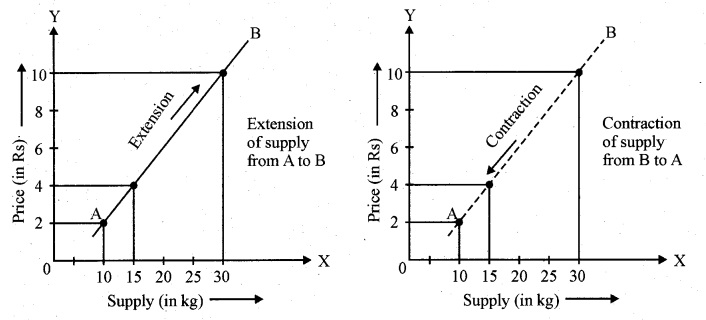
From the given figure of extension in supply, it is clear that if price of commodity is ₹ 2 per unit, the quantity supplied is 10 kg. Now, if price rises from ₹ 2 to ₹ 10, the quantity supplied increases from 10 to 30 units. This is extension of supply.
Likewise, from the given figure of contraction of supply, it is clear that when price reduces from ₹ 10 to ₹ 2, the quantity supplied reduces from 30 units to 10 units only. This has been shown by movement from B to A. This is termed as a Contraction of Supply.
RBSE Class 12 Economics Chapter 5 Other Important Questions – Answers
RBSE Class 12 Economics Chapter 5 Multiple-Choice Questions
Question 1.
A vertical supply curve parallel to Y axis implies that the elasticity of supply is :
(a) zero
(b) infinity
(c) equal to one
(d) greater than zero but less infinity
Answer:
(a)
Question 2.
The supply of goods refers to :
(a) actual production of the good
(b) total existing stock of the good
(c) stock available for sale
(d) amount of the good offered for sale at a particular price per unit of time
Answer:
(d)
Question 3.
An increase in the supply of a good is caused by :
(a) improvements in its technology
(b) fall in the prices of factors of production
(c) rise in the prices of competitive goods
(d) All of the above
Answer:
(d)
Question 4.
Elasticity of supply refers to the degree of responsiveness of supply of a good to changes in its :
(a) demand
(b) price
(c) cost of production
(d) state of technology
Answer:
(b)
Question 5.
A horizontal supply curve parallel to the quantity axis implies that the elasticity of supply is :
(a) zero
(b) infinite
(c) equal to one
(d) greater than zero but less than one
Answer:
(b)
Question 6.
Contraction of supply is the result of :
(a) decrease in the number of producers
(b) decrease in the price of the good concerned
(c) increase in the prices of other goods
(d) decrease in the outlay of sellers
Answer:
(b)
Question 7.
The quantity supplied of a good or service is the amount that :
(a) is actually bought a given time period at a given price
(b) producers wish they could sell at a higher price
(c) producers plan to sell during a given time period at a given price
(d) people are willing to buy during a given time period at a given price
Answer:
(c)
Question 8.
Supply is the :
(a) limited resources that are available with the seller
(b) cost of producing a good
(c) entire relationship between the quantity supplied and the price of good
(d) willingness to produce a good if the technology to produce it becomes available
Answer:
(c)
Question 9.
If the supply of bottled water decreases, equilibrium price ……………….. and the equilibrium quantity ………………..
(a) increases; decreases
(b) decreases; increases
(c) decreases; decreases
(d) increases; increases
Answer:
(a)
Question 10.
In a very short period the supply
(a) can be changed
(b) cannot be changed
(c) can be increased
(d) increases; increased
Answer:
(b)
Question 11.
A lpwer supply curve indicates
(a) smaller supply
(b) larger supply
(c) constant supply
(d) None of the above
Answer:
(b)
Question 12.
When supply curve moves to right it means :
(a) supply increases
(b) supply decreases
(c) supply remains constant
(d) None of these
Answer:
(a)
Question 13.
The elasticity of supply is defined as the :
(a) responsiveness of the quantity supplied of a good to a change in its price.
(b) responsiveness of the quantity supplied of a good without change in its price.
(c) responsiveness of the quantity demanded of a good to a change in its price.
(d) responsiveness of the quantity demanded of a good without change in its price.
Answer:
(a)
Question 14.
Elasticity of supply is measured by dividing the percentage change in quantity supplied of a good by :
(a) percentage change in income
(b) percentage change in quantity demanded of goods
(c) percentage change in price
(d) percentage change in taste and preference
Answer:
(c)
Question 15.
Elasticity of supply is zero means :
(a) perfectly inelastic supply
(b) perfectly elastic supply
(c) imperfectly elastic supply
(d) None of the above
Answer:
(a)
Question 16.
Elasticity of supply is greater than one when :
(a) proportionate change in quantity supplied is more than the proportionate change in price
(b) proportionate change in price is greater than the proportionate change in quantity supplied
(c) change in price and quantity supplied are equal
(d) None of these
Answer:
(a)
Question 17.
If the change in quantity supplied is exactly equal to the relative change in price then the elasticity of supply is :
(a) less than one
(b) greater than one
(c) one
(d) None of these
Answer:
(c)
Question 18.
The supply function is given as Q = 100 + 10P. Find the elasticity of supply using point method, when price is ₹ 15.
(a) 4
(b) – 3
(c) – 5
(d) 3
Answer:
(d)
RBSE Class 12 Economics Chapter 5 Very Short Answer Type Questions
Question 1.
Give the meaning of supply schedule.
Answer:
Supply of different quantities placed in the market at different prices are mentioned ‘ with the help of a schedule called Supply Schedule.
Question 2.
What causes a movement along a supply curve of a good?
Answer:.
When the quantity supplied changes due to the change in price of the commodity, it is called Movement Along a Supply Curve of a good.
Question 3.
What is meant by extension of supply?
Answer:
Extension of supply refers to the increase in quantity supplied of a commodity due to rise in price.
Question 4.
What is meant by contraction of supply?
Answer:
Contraction of supply refers to the decrease in quantity supplied of a commodity due to fall in price. .
Question 5.
What is meant by increase in supply?
Answer:
Supply rise due to the changes in other factors, such as change in technology and change in input cost is known as Increase in Supply.
Question 6.
What is meant by decrease in supply?
Answer:
Supply fall due to the changes in other factors, such as change in technology and change in input cost is known as Decrease in Supply.
Question 7.
When is the supply of a commodity called ‘elastic’?
Answer:
It is the degree of responsiveness of supply due to change in price when change in price induces change in supply.
Question 8.
When does supply become more elastic?
Answer:
When the change in supply is more than proportionate to the change in price, it is the case of highly elastic supply.
Question 9.
When does supply become less elastic?
Answer:
When the change in supply is lesser than proportionate change in price, it is.the case of less elastic supply.
Question 10.
State the law of supply.
Answer:
When the price of a commodity rises, its quantity supplied in the market increases, and when the price of a commodity falls, its quantity supplied decreases, while other factors determining supply remain the same.
Question 11.
What is meant by zero elastic supply?
Answer:
When there is no change in quantity supplied in response to change in price, it is known as Perfectly Inelastic Supply or Zero Elasticity of Supply.
Question 12.
Draw a supply curve with unitary elasticity.
Answer:
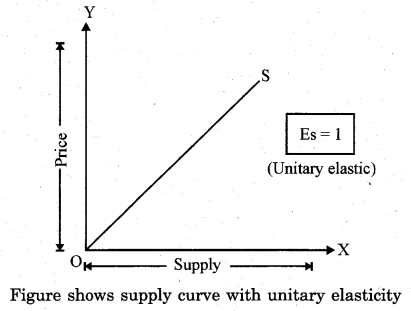
Question 13.
What causes an upward movement along a supply curve?
Answer:
Supply curve moves upward from left to right if there is a rise in price. If prices increase, the sellers will be willing to sell more products and producers will be willing to produce more products. This happens when other situations are not changed such as price of substitutes, change in taste and technology, chailge in input costs and expectation of prices to rise in the future.
Question 14.
What causes a downward movement along a supply curve?
Answer:
Downward movement along the supply curve implies contraction of the quantity supplied and contraction of supply refers to the fall in supply due to fall in price of the commodity, when all the other factors of supply remain constant.
Question 15.
Why does change in supply takes place when price remains constant at f 10 per unit and the supply increases from 25 units to 40 units?
Answer:
Supply increases when price remains constant. This can be due to the cheaper availability of input or technological improvements, which can reduce the cost of production or other such factors.
Question 16.
When at a constant price, a producer reduces the sale of his product from 18 to 15. What will you call this change in supply?
Answer:
This change in supply is called Decrease in Supply. This can be due to an increase in input costs or other factors.
Question 17.
What will be the effect on the supply of Pepsi when its price falls compared to that of Coca Cola ?
Answer:
The supply of Pepsi increases when the price of Pepsi falls because Pepsi and Coca Cola are substitute or competing goods.
Question 18.
State the effect of change in technology on the supply.
Answer:
Improvement in technology brings reduction in cost and increase in production and increase in the level of supply.
Question 19.
Define market supply.
Answer:
Market supply refers to supply of a commodity by all the firms in the market producing/selling that particular commodity.
Question 20.
Price elasticity of supply of a good is 0.8. Is the supply ‘elastic’ or ‘inelastic’ and why?
Answer:
Supply is inelastic because the given price elasticity of supply is 0.8 which is less than 1.
RBSE Class 12 Economics Chapter 5 Short Answer Type Questions
Question 1.
Distinguish between stock and supply.
Answer:
Stock of a commodity refers to the total quantity of that commodity which at any given time is available in the market with the seller, whereas supply refers to that part of the stock that the seller is prepared to sell considering different possible prices of the commodity, at a given time.
Question 2.
Distinguish between ‘decrease in supply’ and ‘contraction of supply’.
Answer:
When due to fall in price of a commodity, the quantity of its supply decreases, and the supply is reduced, it is called contraction of supply. When the quantity of supply decreases due to factors other than change in price, it is called decrease in supply. In contraction of supply, we proceed along the same supply curve, while in decrease of supply, the entire curve shifts towards’the left.
Question 3.
State and explain the law of supply.
Answer:
According to the law of supply, when the price of a commodity rises, its quantity supplied in the market increases, and when the price of a commodity falls, its quantity supplied decreases, other factors determining supply remaining the same. Thus, the quantity supplied of a commodity is directly or positively related to price. It is due to this direct relationship between price of a commodity and its quantity supplied that the supply curve of a commodity slopes upward to the right.
Question 4.
Explain the methods of measuring elasticity of supply.
Answer:
There are two methods of measuring price elasticity of supply. These are:
(i) Proportionate Method : In this method, elasticity of supply (Es), is the proportion of ‘percentage change in quantity supplied’ and ‘percentage change in price’ of the commodity.

(ii) Geometric Method : Geometrically, elasticity of supply depends on the ‘origin’ of the supply curve. The geometric method shows elasticity of supply by three different cases. These are:
(a) When a straight line, positively sloped supply curve starts from the point of origin ‘O’. In this case Es = 1.
(b) When a straight line, positively sloped supply curve starts from Y-axis. In this case Es > 1.
(c) When a straight line, positively sloped supply curve starts from X-axis. In this case Es < 1.
Question 5.
State three causes of increase in supply.
Answer:
Factors which lead to an increase in supply are the following:
- Changes in the goals of producers.
- Fall in the price of other commodities.
- Fair in the price of factors of production.
Question 6.
State three causes of a rightward shift of supply curve.
Answer:
Three causes of a rightward shift of supply curve are:
- Change in production cost.
- Increasing use of technology in production.
- Change in the size of industry.
Question 7.
What are the different types of elasticity of supply?
Answer:
Types of elasticity of supply are:
(i) Perfectly Inelastic Supply : When there is no change in quantity supplied in response to change in price, it is known as Perfectly Inelastic Supply or zero Elasticity of Supply.
(ii) Unitary Elastic Supply : When the proportionate change in supply equals the proportionate change in price, it is the case of unitary elasticity of supply.
(iii) Perfectly Elastic Supply : When at a particular level of price, sellers are willing to supply infinite amounts of supply but nothing will be supplied at a price lower than this, it is the case of perfectly elastic supply.
(iv) More than Unitary Elastic : When the change in supply is more than proportionate to the change in price, it is the case of highly elastic supply.
(v) Less than Unitary Elastic or Less Elastic : When the change in supply is lesser than proportionate change in price, it is the case of less elastic supply.
Question 8.
If the market price of a commodity is ₹ 4, a seller is willing to sell 600 units of the commodity. When the price rises to ₹ 5, he is willing to sell 750 units of the commodity. What is the seller’s elasticity of supply?
Answer:
When the change in supply is equal to the proportionate change in price, it is the case of unit elasticity of supply.

It is the case of unit elastic of supply.
Question 9.
A producer offers to sell 400 units of a commodity when its price is ₹ 10 per unit, while only 200 units are offered if the price reduces to ₹ 5 per unit. Find elasticity of supply.
Answer:
Given, P = ₹ 10, Q = 400, AP = ₹ 5, ∆Q = 200 units

Question 10.
Explain the meaning of price elasticity of supply.
Answer:
Price elasticity of supply is the measure of change in supply of a commodity due to change in its price. Law of supply tells us how the supply will change as a result of change in price; that is fall and increase in price will lead to contraction and extension of supply. But if we want to know how much supply will be increased compared to say 10 per cent increase in price, or which proportion change in the supply will occur, then we have to study the flexibility of supply. Thus, there is a proportional change in the supply after the proportional change in price elasticity in the supply.
Question 11.
Define increase in supply. How is it different from extension of supply?
Answer:
Increase in supply is a situation when firms are willing to supply more of a commodity at its existing price. It may be owing to cheaper availability of inputs or due to technological improvements causing reduction in cost of production, or other such factors. While extension in supply of a commodity occurs as a result of rise in price of the commodity. Increase in supply means that due to reduction of price of resources, advancement in technology, whole supply curve shifts to the right, showing that more quantity is supplied than before at each decline in price of the commodity.
Question 12.
What is the position of supply curve, when the excise tax is paid?
Answer:

Generally, excise tax is applied per unit of a firm’s production. Accordingly, the marginal and average cost of the manufacturer increases. In that case, a producer should be ready to sell less at the current price, or he will sell the same quantity at an increased price. This means that the supply curve is in the condition of a lack of supply as compared to previous state. Following graphical presentation shows that when the excise duty levied, he is willing to sell only PK. Supply curve shifts backward from S1 S1 to S2 S2.
RBSE Class 12 Economics Chapter 5 Essay Type Questions
Question 1.
Make hypothetical supply schedule of perfectly inelastic and elastic supply and present them through diagram.
Answer:
Hypothetical supply schedule of perfectly inelastic and elastic supply along with diagram is given below:
(i) Perfectly Inelastic Supply : When there is no change in quantity of supply in response to change in price, it is known as Zero Elasticity of supply or Completely Stable Supply. The supply curves become vertical or parallel to the Y-axis, supply of rare books, postage stamps, coins, etc. is completely stable. Since these items are rare, despite change in price, there can be no change in their supply. For example, if the supply of rare coins is one hundred, it will remain the same, whether their price is ₹ 5,000 per coin or ₹ 50,000 per coin. It should be clear from the given below schedule and diagram :
| Price Per Unit (in ₹) | Quantity Supplied |
| 5,000 | 100 |
| 50,000 | 100 |
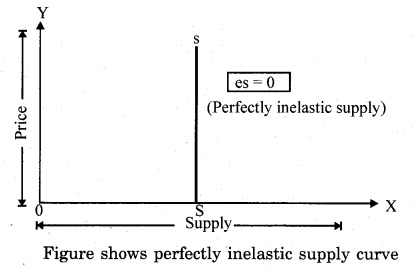
(ii) Perfectly Elastic Supply : When at a particular level of price, the vendor is ready to supply in unlimited quantities, but nothing will be given at a lower cost, it is a case of perfectly elastic supply, and the supply curve becomes parallel to the X-axis or horizontal. Supply of commodity may increase or decrease to any extent without any change or infinitesimal change in its price. It should be clear from the given below schedule and diagram:
| Price Per Unit (in ₹) | Quantity Supplied (Units) |
| 7 | 10 |
| 7 | 15 |
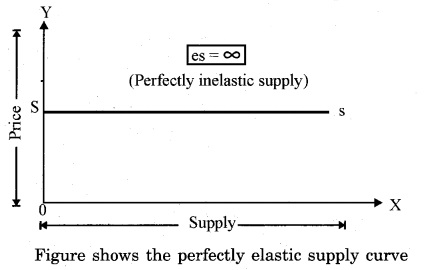
It appears from the schedule that the price of the commodities remaining the same, supply has considerably increased.
Question 2.
With the help of a diagram, explain the difference between movement on the supply curve and a shift of the demand curve.
Answer:
Supply refers to the position of the supply curve, whereas the quantity supplied refers to the amount of supplier’s wish to sell. For example, when hot weather drives up the price of ice cream, the quantity of ice cream that firms supply rises, even though the supply curve remains the same. So supply does not change because the weather does not alter the firms’ desire to sell at any given price. Instead, the hot weather alters consumers’ desire to buy at any given price and thereby shifts the demand curve.
The increase in demand causes the equilibrium price to rise. When the price rises, the quantity supplied rises. This increase f in quantity supplied is represented by the movement along the supply curve. To summarize, a shift in the supply curve is called a “Change in Supply,” and shift in demand curve is called a “Change in Demand.” A movement along a fixed supply curve is called a “Change in the Quantity Supplied,” and a movement along a fixed demand curve is called a “Change in the Quantity Demanded.”
For example, suppose that during another summer, a hurricane destroys a part of the sugarcane crop and drives up the price of sugar. How does this event affect the market for ice cream? We have to understand the hurricane effect in three steps:
(i) The change in the price of sugar, an input into making ice cream, affects the supply curve. By raising the cost of production, it reduces the amount of ice cream that firms produce and sell at any given price. The demand curve does not change because the higher cost of inputs does not directly affect the amount 6f ice cream the household wishes to buy.
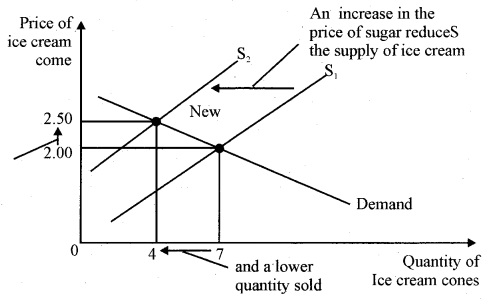
(ii) The supply curve shifts to the left because, at every price, the total amount that firms are willing and able to sell is reduced. The given below figure reflects the decrease in supply as a shift in the supply curve from S1 to S2.
(iii) The figure shows the shift in the supply curve raises the equilibrium price from $ 2.00 to $ 2.50 and lowers the equilibrium quantity from 7 to 4 cones. As a result of the sugar price increase, the price of ice cream rises, and the quantity of ice cream sold falls.
An event that reduces quantity supplied at any given price shifts the supply curve to the left. The equilibrium price rises, and the equilibrium quantity falls. Here, an increase in the price of sugar (an input) causes seller to supply less ice cream. The supply curve shifts for S1 to S2 which causes the equilibrium price of ice cream to rise from $ 2.00 to $ 2.50 and the equilibrium quantity to fall from 7 to 4 cones.
Question 3.
Discuss the factors that determine the supply of a commodity.
Answer:
These are the main factors that determine the supply of a commodity:
(i) Nature of the Inputs Used : The elasticity of supply depends on the nature of inputs used for the production of commodity. If the production of a product utilizes factor of production that are commonly used to produce other products, it will tend to have a more elastic supply. On the other hand, if it uses specialized factors of production suited only for its production, its supply will be relatively inelastic.
(ii) Nature and Size of the Industry : The supply of a commodity depends also on whether an industry is monopolized or competitive. Under monopoly, supply is fixed. When a monopolized industry is made competitive, the total supply increases. Besides, if size of an industry increases due to new firms joining the industry, the total supply increases and supply curve shifts rightward.
(iii) Risk Bearer : The elasticity of supply depends on the willingness of the entrepreneurs to take risk. If the entrepreneurs are willing to take risk, the supply will be more elastic. On the other hand, if the entrepreneurs hesitate to take risk, the supply will be inelastic.
(iv) Cost of Production : If the marginal cost of commodity is increasing, the producer will not like to produce it more even if its price is increasing. He may go on producing additional units if the rate of increase in price is higher than the rate of increase in the marginal cost. On the contrary, if the marginal cost of production has been falling or is lesser than the market price of the commodity, the producer will be induced to increase the supply, so that he may earn more profit.
(v) Time Factor: The supply of commodity can be easily raised or curtailed in the long period as per the requirement, so the elasticity of supply will be inelastic in the short term, because the supply cannot be raised or curtailed easily in the short period.
(vi) Technological Progress : Technological changes that reduce cost of production or increase efficiency cause increase in product supply. For instance, introduction of high yielding variety of paddy and new techniques of cultivation increased per acre yield of rice in India in the 1970s. Such changes make the supply curve shift to the right.
(vii) Price of Product Substitutes : In production of many commodities, it is possible to produce some other goods which require a similar technology. For example, a refrigerator company can also produce ACs; Tata, famous for truck production, can also produce cars; Maruti Udyog can produce trucks, and so on. Fall in the price bf one of the product substitutes may lead to the rise in the supply- of other products due to capacity utilization for profit maximization.
(viii) Government Policy : When government imposes restrictions on production, e.g., import quota on inputs, rationing of or quota imposed on input supply, etc. production tends to fall. Such restrictions make supply curve to shift leftward.
Question 4.
Explain three degrees of elasticity of supply with the help of diagrams.
Answer:
Three degrees of elasticity of supply are:
(i) Unit Elastic Supply: When the proportionate change in supply equals the proportionate change in price, it is the case of unit elasticity of supply (es = 1). In this case, a straight line supply curve passes through the origin O. Both price and the supply of the commodity increase or decrease at the same rate. In other words, if price increases by 50%, supply will also increase by 50%. It is described by the below given schedule:
| Price Per Unit | Quantity Supplied |
| 40 | 400 |
| 60 | 600 |
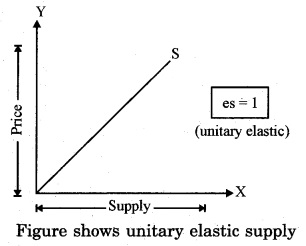
It reflects from the given above schedule that both price and supply have increase by 50%.
(ii) Greater than Unit Elastic Supply : When the change in supply is more than proportionate to the change in price, it is the case of highly elastic supply (es > 1). The positively sloped straight line supply curve meets the line of the Y-axis above the origin O. In this case, percentage change in the supply is more than percentage change in price. For example, the price increased by 20%, but the supply increased by 50%. Let us consider the following schedule:
| Price Per Unit | Quantity Supplied |
| 20 | 100 |
| 24 | 150 |
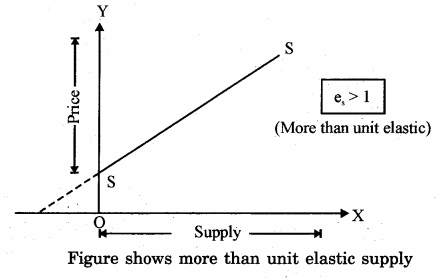
It reflects from the schedule that price increased by 20% but the supply increased by 50%.
(iii)Less than Unit Elastic or Less Elastic Supply : When the change in supply is lesser than proportionate change in price, it is the case of less elastic supply (es < 1). A positively sloped straight line supply curve meets the line of the X-axis to the right of origin O. In this case, percentage change in supply is lesser than the percentage change in price. For example, price increases by 50%, but the supply increases by 20% only. Let us consider the following schedule:
| Price Per Unit | Quantity Supplied |
| 50 | 100 |
| 75 | 120 |
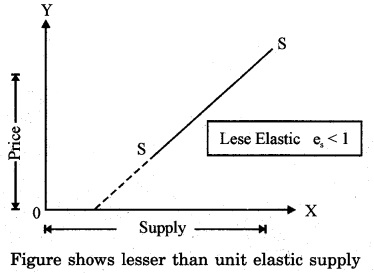
Question 5.
Supply of a commodity was 1,200 units at a price of ₹ 12 per unit. If the supply of the commodity increased to 1,600 units, what will be the new price of commodity if the elasticity of supply is 2?
Answer:
Let the new price of commodity = P1
So, putting all values in the given below formula:
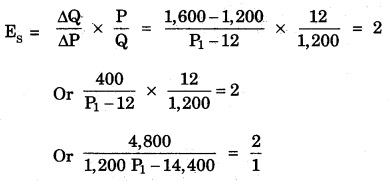
Or 2,400 P1 – 28,800 = 4,800
Or 2,400 P1 = 4,800 + 28,800
Or P1 = 33,600 / 2,400 = 14
New price of commodity (P1) = ₹ 14
RBSE Solutions for Class 12 Economics